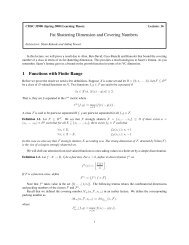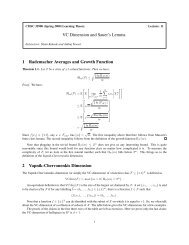Relax and Randomize: From Value to Algorithms
Relax and Randomize: From Value to Algorithms
Relax and Randomize: From Value to Algorithms
Create successful ePaper yourself
Turn your PDF publications into a flip-book with our unique Google optimized e-Paper software.
Lemma 12. The relaxation specified in Equation (21) is admissible w.r.t. the r<strong>and</strong>omized prediction<br />
strategy specified in Equation (25), <strong>and</strong> enjoys bound E [Reg T ] ≤ 2L E ɛ [sup f∈F ∑ T t=1 ɛ t f[t]] .<br />
6 Matrix Completion<br />
Consider the problem of predicting unknown entries in a matrix, in an online fashion. At each round<br />
t the adversary picks an entry in an m × n matrix <strong>and</strong> a value y t for that entry. The learner then<br />
chooses a predicted value ŷ t , <strong>and</strong> suffers loss l(y t , ŷ t ), assumed <strong>to</strong> be ρ-Lipschitz. We define our<br />
regret with respect <strong>to</strong> the class F of all matrices whose trace-norm is at most B (namely, we can<br />
use any such matrix <strong>to</strong> predict just by returning its relevant entry at each round). Usually, one has<br />
B = Θ( √ mn). Consider a transductive version, where we know in advance the location of all<br />
entries we need <strong>to</strong> predict. We show how <strong>to</strong> develop an algorithm whose regret is bounded by the<br />
(transductive) Rademacher complexity of F, which by Theorem 6 of [17], is O(B √ n) independent<br />
of T . Moreover, in [7], it was shown how one can convert algorithms with such guarantees <strong>to</strong> obtain<br />
the same regret even in a “fully” online case, where the set of entry locations is unknown in advance.<br />
In this section we use the two alternatives provided for transductive learning problem in the previous<br />
subsection, <strong>and</strong> provide two alternatives for the matrix completion problem. Both variants proposed<br />
here improve on the one provided by the R 2 forecaster in [7], since that algorithm competes against<br />
the smaller class F ′ of matrices with bounded trace-norm <strong>and</strong> bounded individual entries, <strong>and</strong> our<br />
variants are also computationally more efficient. Our first variant also improves on the recently<br />
proposed method in [8] in terms of memory requirements, <strong>and</strong> each iteration is simpler: Whereas<br />
that method requires s<strong>to</strong>ring <strong>and</strong> optimizing full m × n matrices every iteration, our algorithm only<br />
requires computing spectral norms of sparse matrices (assuming T ≪ mn, which is usually the<br />
case). This can be done very efficiently, e.g. with power iterations or the Lanczos method.<br />
Our first algorithm follows from Eq. (24), which for our setting gives the following prediction rule:<br />
ŷ t = B E<br />
ɛ<br />
[(∥<br />
T<br />
∑<br />
i=t+1<br />
ɛ ix i − 1<br />
t−1<br />
2ρ<br />
∑ ∂l(ŷ i, y i)x i + 1 xt∥ 2<br />
i=1 σ<br />
− ∥<br />
T<br />
∑<br />
i=t+1<br />
ɛ ix i − 1<br />
t−1<br />
2ρ<br />
∑ ∂l(ŷ i, y i)x i − 1 xt∥ )] (26)<br />
2<br />
i=1 σ<br />
In the above ∥⋅∥ σ<br />
st<strong>and</strong>s for the spectral norm <strong>and</strong> each x i is a matrix with a 1 at some specific position<br />
<strong>and</strong> 0 elsewhere. Notice that the algorithm only involves calculation of spectral norms on each<br />
round, which can be done efficiently. As mentioned in previous subsection, one can approximately<br />
evaluate the expectation by sampling several ɛ’s on each round <strong>and</strong> averaging. The second algorithm<br />
follows (25), <strong>and</strong> is given by first drawing ɛ at r<strong>and</strong>om <strong>and</strong> then predicting<br />
ŷ t(ɛ)= sup {<br />
∥f∥ Σ ≤B<br />
T<br />
∑ɛ if[x i]− 1<br />
i=t+1<br />
2ρ<br />
t−1<br />
∑<br />
i=1<br />
l(f[x i], y i)+ 1 f[xt]}− sup<br />
2<br />
∥f∥ Σ ≤B<br />
T<br />
{ ∑ɛ if[x i]− 1<br />
i=t+1<br />
2ρ<br />
t−1<br />
∑<br />
i=1<br />
l(f[x i], y i)− 1 2 f[xt]}<br />
where ∥f∥ Σ<br />
is the trace norm of the m×n f, <strong>and</strong> f[x i ] is the entry of the matrix f at the position x i .<br />
Notice that the above involves solving two trace norm constrained convex optimization problems per<br />
round. As a simple corollary of Lemma 12, <strong>to</strong>gether with the bound on the Rademacher complexity<br />
mentioned earlier, we get that the expected regret of either variant is O (B ρ ( √ m + √ n)).<br />
7 Conclusion<br />
In [2, 1, 14, 19] the minimax value of the online learning game has been analyzed <strong>and</strong> nonconstructive<br />
bounds on the value have been provided. In this paper, we provide a general constructive<br />
recipe for deriving new (<strong>and</strong> old) online learning algorithms, using techniques from the<br />
apparently non-constructive minimax analysis. The recipe is rather simple: we start with the notion<br />
of conditional sequential Rademacher complexity, <strong>and</strong> find an “admissible” relaxation which upper<br />
bounds it. This relaxation immediately leads <strong>to</strong> an online learning algorithm, as well as <strong>to</strong> an associated<br />
regret guarantee. In addition <strong>to</strong> the development of a unified algorithmic framework, our<br />
contributions include (1) a new algorithm for online binary classification whenever the Littles<strong>to</strong>ne<br />
dimension of the class is finite; (2) a family of r<strong>and</strong>omized online learning algorithms based on the<br />
idea of a r<strong>and</strong>om playout, with new Follow the Perturbed Leader style algorithms arising as special<br />
cases; <strong>and</strong> (3) efficient algorithms for trace norm based online matrix completion problem which<br />
improve over currently known methods.<br />
8




